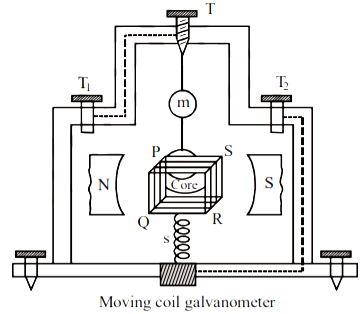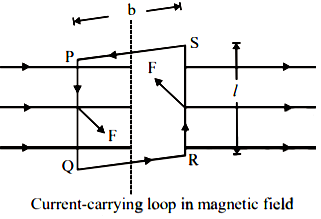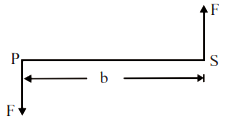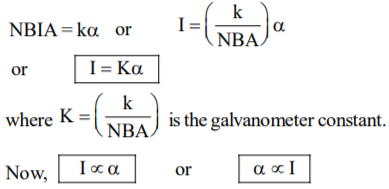Principle : When a current-carrying coil is placed in magnetic field, it experiences a torque.
Construction : It consists of a narrow rectangular coil PQRS consisting of a large number of turns of fine insulated copper wire wound over a frame made of light, non-magnetic metal. A soft iron cylinder known as the core is placed symmetrically within the coil and detached from it. The coil is suspended between the two cylindrical pole-pieces(N and of a strong permanent horse-shoe magnet) by a thin flat phosphor bronze strip, the upper end of which is connected to a movable torsion head T. The lower end of the coil is connected to a hair-spring ‘’ of phosphor bronze having only a few turns.

In order to eliminate air-disturbance, the whole arrangement is enclosed in a brass case having a glass window on the front. Leveling screws are provided at the base.The torsion head T is connected to a binding terminal T1. So, the phosphor-bronze strip acts as one ‘current lead’ to the coil. The lower end of the spring ‘*’ is connected to a binding terminal T2 . A plane mirror or a concave mirror of larger radius of curvature is rigidly attached to the phosphor bronze strip. This helps to measure the deflection of the coil by lamp and scale arrangement.
Theory :
Let I = current flowing through the coil;
B=magnetic field induction
l = length of the coil;
b = breadth of the coil
N = number of turns in the coil;
A(= l × b) = area of the coil
Since the field is radial, therefore, the plane of the coil *** parallel to the magnetic field in all the orientations of the coil. So, the sides SP and QR remain parallel to the direction of the magnetic field. So, they do not experience any force.The sides PQ and RS remain perpendicular to the direction of the magnetic field. These sides experience forces perpendicular to the plane of the coil.

Force on PQ, F = NBIl
Applying Fleming’* left hand rule, we find that this force is normal to the plane of the coil and directed outwards, i.e., towards the reader.
Force on RS, F = NBIl
Applying Fleming’* left hand rule, we find that this force is normal to the plane of the coil and directed inwards, i.e., away from the reader.
The forces on the sides PQ and RS are :
(i) equal in magnitude;(ii) opposite in direction; and (iii) act at different points. So, the two forces constitute a couple. This couple tends to deflect the coil and is known as deflecting couple.
Moment of deflecting couple = NBIl × b = NBIA
[The field is radial. The forces on the sides PQ and RS always remain perpendicular to the plane of the coil. So, the perpendicular distance between the forces is always equal to ‘b’ as in fig.]

When the coil deflects, the suspension fibre gets twisted. On account of elasticity, a restoring couple is set up in the fibre. This couple is proportional to the twist. If α be the angular twist, then
Moment of restoring couple = kα
where ‘k’ is the restoring couple per unit angular twist. It is also known as torsional constant. For equilibrium of the coil,

So, the deflection of the coil is proportional to the current flowing through the coil. This explains as to why we can use a linear scale in a galvanometer. The scale is calibrated to give direct values of current.